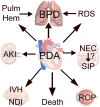Prophylactic Indomethacin Revisited
- PMID: 28396028
- PMCID: PMC5520627
- DOI: 10.1016/j.jpeds.2017.03.036
Prophylactic Indomethacin Revisited
Abstract
Persistent patency of the ductus arteriosus (PDA) has challenged neonatologists for more than 40 years., Surgical ligation of the ductus was first performed in children nearly 80 years ago and proved that prevention of prolonged exposure to left-to-right shunting through the ductus arteriosus improved pulmonary, cardiac, and systemic outcomes. In the 1970s, the discovery that nonsteroidal anti-inflammatory drugs could induce PDA closure– and are effective in infants born preterm, provided neonatologists with a pharmacologic alternative to surgery. The clear advantages, however, of having a medical approach have been clouded by conflicting information on the long-term benefits of treatment, disagreement regarding the clinical indicators that warrant treatment for PDA, optimal drug choice, preferred dosing regimens, and indecision regarding the best time to treat a select population of fragile preterm infants.
Keywords: bronchopulmonary dysplasia; ductus arteriosus; indomethacin; prophylaxis.
Conflict of interest statement
The authors declare no conflicts of interest.
Figures


Comment on
-
Association between Use of Prophylactic Indomethacin and the Risk for Bronchopulmonary Dysplasia in Extremely Preterm Infants.J Pediatr. 2017 Jul;186:34-40.e2. doi: 10.1016/j.jpeds.2017.02.003. Epub 2017 Feb 28. J Pediatr. 2017. PMID: 28258737 Free PMC article.
References
-
- Lees MH. Commentary: patent ductus arteriosus in premature infants—a diagnostic and therapeutic dilemma. J Pediatr. 1975;86:132–4. - PubMed
-
- Evans N. Preterm patent ductus arteriosus: a continuing conundrum for the neonatologist? Semin Fetal Neonatal Med. 2015;20:272–7. - PubMed
-
- Alexi-Meskishvili VV, Bottcher W. The first closure of the persistent ductus arteriosus. Ann Thorac Surg. 2010;90:349–56. - PubMed
-
- Starling MB, Elliott RB. The effects of prostaglandins, prostaglandin inhibitors, and oxygen on the closure of the ductus arteriosus, pulmonary arteries and umbilical vessels in vitro. Prostaglandins. 1974;8:187–203. - PubMed
-
- Sharpe GL, Thalme B, Larsson KS. Studies on closure of the ductus arteriosus. XI. Ductal closure in utero by a prostaglandin synthetase inhibitor. Prostaglandins. 1974;8:363–8. - PubMed
Publication types
MeSH terms
Substances
Grants and funding
LinkOut - more resources
Full Text Sources
Other Literature Sources

